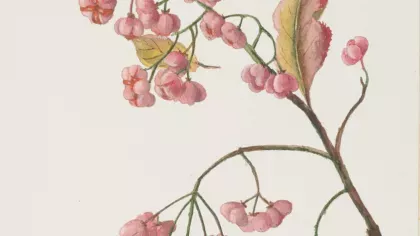History of Kew
Our Gardens date back to the early 18th century, as a royal palace to today's globally renowned scientific institution for plant and fungal research.

- 1759: Princess Augusta, mother of King George III, founds a nine-acre botanic garden within the pleasure grounds at Kew.
- 1762: William Chambers builds the Great Pagoda.
- 1768: Joseph Banks sends seeds to Kew whilst on Captain Cook's voyage to South Seas, and becomes Kew's first unofficial director on his return.
- 1772: Francis Masson, Kew's first plant collector, goes to South Africa and returns with thousands of plants.
- 1773: Capability Brown creates the Hollow Walk, now the Rhododendron Dell.
- 1788: HMS Bounty goes to Tahiti with two Kew gardeners and collects 1,000 breadfruit plants. En route to Jamaica, the crew mutinies.
- 1802: King George III unites the Richmond and Kew estates.
- 1840: Kew transferred from the Crown to the government. Sir William Hooker is appointed director. The Gardens are opened to the public.
- 1841: Joseph Hooker brings plants from Falklands to Kew in glazed Wardian cases, a new way to keep plants alive on voyages.
- 1848: The Palm House is completed.
- 1853: The Herbarium is built. Today, after five extensions, it holds over seven million species.
- 1863: The Temperate House opens.
- 1865: On the death of his father, Joseph Dalton Hooker succeeds as director to Kew.
- 1876: Jodrell Laboratory is built. Work begins on plant pathology, and later on cells that produce latex.
1882: The Marianne North Gallery opens. - 1889:Titan arum (corpse flower) blooms at Kew, the first time outside its native Sumatra.
- 1896: Women are first employed as gardeners at Kew.
- 1899: Temperate House is completed.
- 1911: Japanese Gateway 'Chokushi-Mon' is presented to Kew.
- 1913: Suffragettes attack glasshouse and burn down Kew's tea pavilion. Two are jailed.
- 1930: Imperial Bureau of Mycology move to site by Herbarium
- 1939: Dig for Victory! Vegetables and medicinal plants are grown at Kew to support the war effort.
- 1952: Crick and Watson discover structure of DNA; a breakthrough that underpins Kew's current scientific research on genetic diversity of plants.
- 1963: Kew's Diploma in Horticulture is introduced.
- 1965: Seed research begins in Kew's Plant Physiology department.
- 1970: Biochemical systematics word takes off at Kew.
- 1978; Low temperate seed bank is set up at Wakehurst.
- 1987: Princess of Wales conservatory is opened.
- 1996: Restored Japanese Gateway and landscape is opened by Her Imperial Highness Princess Sayako.
- 1997: Wellcome Trust donation enables construction of the Millennium Seed Bank.
- 2003: Kew Gardens is officially inscribed as a UNESCO World Heritage Site. Davies House opens.
- 2006: The award-winning Crossing opens to bridge the Lake.
- 2007: The billionth seed is banked at the Millennium Seed Bank.
- 2008: The Treetop Walkway and The Shirley Sherwood Gallery of Botanical Art opens.
- 2009: The Queen and Prince Phillip visit to celebrate Kew's 250th anniversary. The Herbarium and Library are extended to accommodate 30,000 items added each year.
- 2013: Kew and Big Lottery launch the nationwide 'Grow Wild' campaign supporting communities to grow native wildflowers.
- 2016: The Hive comes to Kew. The Great Broadwalk Borders are completed. Kew publishes the first State of the World's Plants report.
- 2018: After five years of restoration, the Temperate House is re-opened. The Great Pagoda is re-opened with 80 newly-restored dragons.


